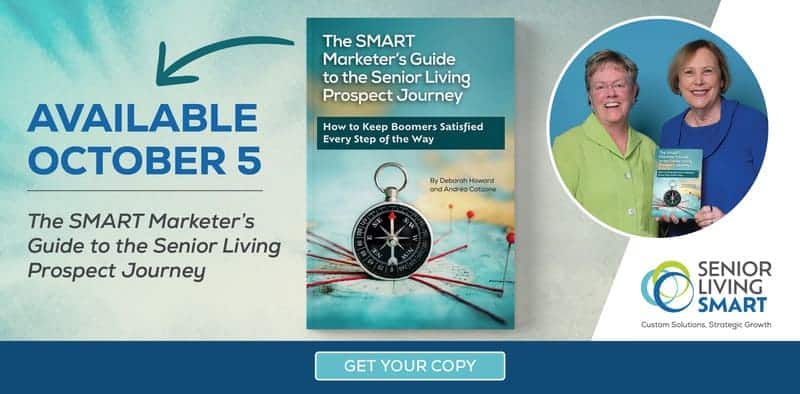Senior Living Marketing Events: 5 Tips for Going Virtual
When it comes to hosting senior living marketing events, everyone has had to pivot this last year, thanks to the pandemic. The good news? Learning how to create effective virtual events will serve your community long after COVID-19 is over.
Why? Well, because virtual events offer two key benefits:
- Anyone can attend. In other words, people aren’t limited by location. This is important for people who might be looking at senior living communities in your area, but they live out of state (or in another part of a big state, like Texas).
- Instant access. Recording virtual events and posting them on your site or social channels means that people can access them when they
Now, let’s discuss tips for creating engaging senior living marketing events for virtual audiences!
1. Develop different types of events for different personas.
For example, create one set of events for seniors/older adults. Create another set of events for adult children who are searching on behalf of their parents. You’ll also want to customize the event to various stages in the buyer’s journey.
For example, an educational seminar called “Can you afford to move into a senior living community?” is quite different from virtual armchair yoga for residents and their families.
And keep in mind that the events you plan for people interested in independent living will (and should) be different from events you plan for people who are interested in memory care.
2. Decide how you’ll broadcast your senior living marketing events.
You’ll do this step in conjunction with the previous step. But it’s so important to a virtual event’s success that we wanted to give it its own step. A variety of platforms exist. Two of the most popular include Zoom and Facebook Live.
Zoom is great for truly formal events. Think events where you want people to register and the topic is incredibly targeted. You have control over who can access/enter the Zoom event. It’s not “open” to the masses—people need a link to access. With Zoom, you have a free version and a paid version. The free version has limitations (like how long you can have a video call).
Facebook Live is excellent for more casual events. Think conversations or last-minute events. Many of our clients had standing Facebook Live chats planned in the early days of the pandemic. For these “events,” anyone could hop on and watch the Facebook Live stream as it was happening. Or they could go to the Facebook page after the event ended and watch the video. (You can also do Instagram Live Events as well.) Facebook Live is also free!
3. Once you’ve selected a platform, pay attention to the details.
You’ll want to test the technology, such as microphones, recording capabilities, and even the lighting in your space. In addition, figure out how interactive you want your event to be. For example, will you use chat, live Q&A sessions, or polls to survey attendees?
Feeling overwhelmed? Not to worry!
We have free guides that’ll walk you through the specifics:
4. Advertise and promote the events appropriately/accordingly.
In other words, make sure you understand the difference between low-cost promotional options and higher-cost options—and which options make the most sense for your events.
- Low-cost promotional options include social media posts, social media advertising (because you can get good results with a small budget), website pop-ups, and email alerts.
- Higher-cost advertising includes print ads in newspapers, direct mail pieces, and radio advertising. You’ll probably want to reserve the higher-cost ads for bigger events, such as authors or big-name speakers.
Keep in mind that a one-size-fits-all approach isn’t a smart strategy. You’ll use different ad combinations, depending on the type of event, your budget, and how much lead time you have to promote it.
Like anything else, measure results. You might discover that running Facebook advertising gives you the biggest bang for your buck—maybe even more so than print ads. Or you might discover the opposite is true—that print ads work better for older adults in your area.
5. Follow up and share your senior living marketing events!
When it comes to these events, record them! Then, SHARE them. Too often, people put on great events and they either forget to record or they don’t share the on-demand events.
- Have a designated area of your website for webinars and past events. Your “Resources” section is a good place for this. For particularly engaging/successful events, you should highlight them on your home page for added traction.
- Send a follow-up email to all registered attendees. Include a link to the recorded event (do not require them to fill out a form).
- Promote the events on social media. And continue to promote them. The shelf life of a social media post isn’t long. You need to continually promote all your content (including recorded events) via all your senior living social media channels.
- Use the events in your ongoing lead nurturing. On-demand webinars and events that people can watch at their leisure make for GREAT lead nurturing fodder.
- Speaking of lead nurturing, create event-specific lead nurturing workflows. For example, if you’ve just delivered an event on the amazing food options in your dining room, the follow-up lead nurturing can share related content, like downloadable dinner menus, a Q&A with your head chef, or a video of a happy resident talking about the food.




